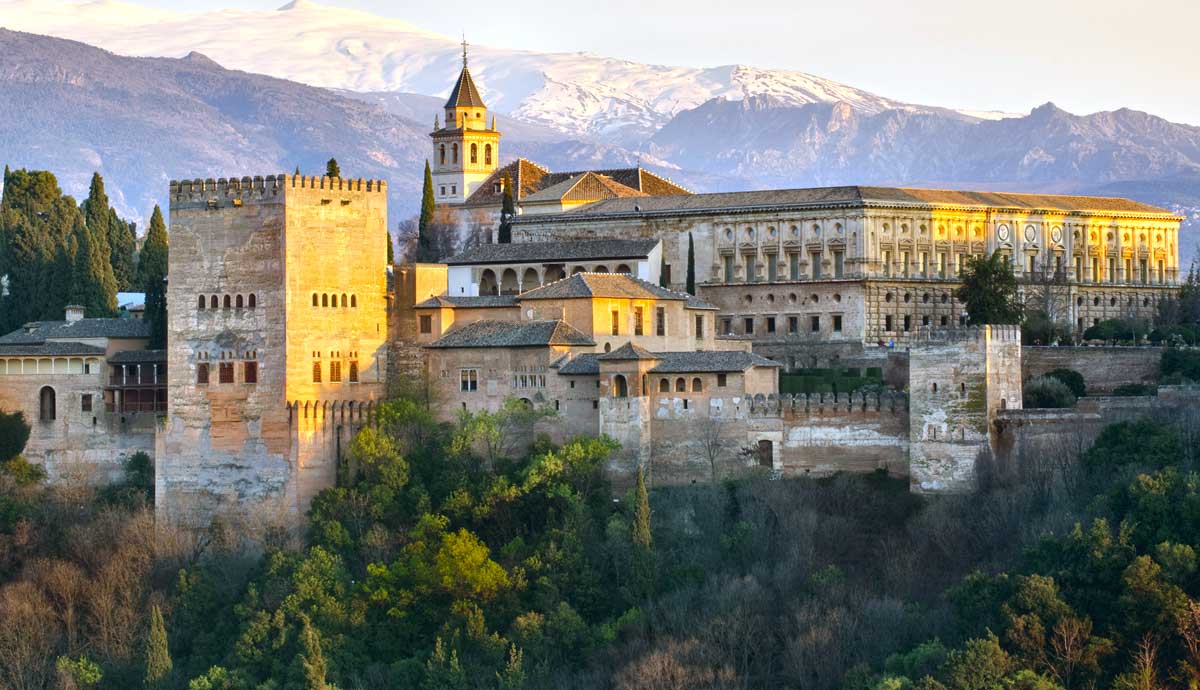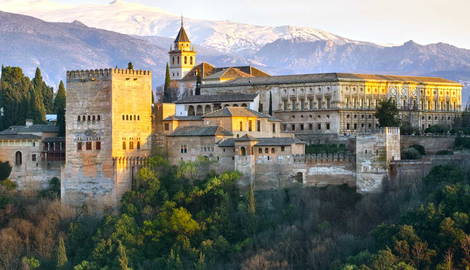
Standing atop a great hill in Granada, the Alhambra Palace remains one of the most magnificent structures in Spain today. Built between 1238 and 1358, the Palace was begun by Muhammad I Ibn al-Ahmar, the first emir of the Nasrid kingdom, and was used as a military fortress until the end of Muslim rule in 1492. With the Nasrids came the longest-reigning Muslim dynasty in the Iberian peninsula, branding the Alhambra with a unique cultural significance as it became one of the best-preserved palaces of the Islamic world.
Who Were the Nasrids, & Who Was Muhammad I?

Rulers of the Emirate of Granada from 1230 to 1492, the Nasrid dynasty was not only the longest Muslim (Moorish) dynasty in the Iberian Peninsula but also the last. The Nasrids descended from the Arab Banu Khazraj tribe, a large Arab tribe based in Medina, who were also situated in Medina during the time of the Islamic Prophet Muhammad. Muhammad ibn Nasr I was the founder of this dynasty and one of his greatest legacies was the construction of the Alhambra Palace.
Succeeding the Umayyad Kingdom, the Nasrids enjoyed a reign that lasted over two centuries, ruling the southern historic city of Granada, along with the neighboring cities of Jaén, Almería, and Málaga. Although the famed “Golden Age” was very much dwindling by this point in Islamic rule due to threatening invading forces, among other factors, Granada remained a crucial military stronghold.
The beginning of Alhambra’s creation in 1238 was fueled by the desire to form a military stronghold in Granada. It rapidly became a crucial hallmark of Islamic civilization in Spain, watching over the city, protected by great mountains and acres of forest. Nasrid rule in Spain came to an end in 1492 with the Christian conquest by Catholic monarchs Ferdinand II and Isabel I, who shared a common desire to recapture territory from the Muslims. Upon launching a series of campaigns spanning an arduous ten years, Granada was surrendered in 1492. Despite the capture of Granada and the subsequent forced conversion of all Spanish Muslims to Christianity, today, Alhambra continues to serve as a significant surviving remnant of Spain’s lengthy Islamic rule.
Why Was the Alhambra Created?

By the arrival of the Nasrids, aggression from Christian threats, as well as growing division among Muslim leaders, had reached new heights. Therefore, it was imperative to establish a military base to fortify the last remaining kingdom.
As previously mentioned, Granada served as the ideal strategic location. The erection of the Palace began with Muhammad I’s exit from Jaen and the establishment of Granada as a military base. The city was far from the Kingdom of Castille’s border and had a direct coastal exit in case of emergency.

Many of the cities surrounding Jaen had previously been conquered by Ferdinand III of Castille, requiring Muhammad I to negotiate the surrender of Jaen to Ferdinand. This resulted in the signing of the Treaty of Jaen in 1246, which demanded that the Nasrids pay an annual tribute of one hundred and fifty thousand maravedis, as well as provide military assistance whenever required by Castille. Muhammad I signed the treaty to buy time for the creation and fortification of the Alhambra to strengthen Nasrid’s military and defense position.
Although it is commonly referred to as a single construction, the Alhambra is composed of numerous intricate structures and towers, all of which served their own unique purpose for the Nasrids. The fortress of the Alhambra was known as the Alcazaba, and it is one of the oldest parts of the palace. The early Nasrid emirs focused on fortifying the Alcazaba as its perimeter wall surrounded the Alhambra and was therefore vital in ensuring the protection and impassibility of the palace.
Amid mounting tensions between the Nasrid and Christian threats around Granada, it was more crucial than ever to guard Nasrid leaders and fortify the city.
How Did the Nasrids Make Use of the Alhambra?

Within the Alhambra, the Alcazaba served as the main residence for Muhammad I and his guards. The outer wall had multiple gates for entrance: the gate of Justice (Bab al-Sharia), the gate of Seven Floors (Bab al-Ghudūr), the gate of Elvira (Bab-Ilbira), the False Gate (Bab al-Faray). The main entrance to the fortress was through the Gate of Arms, while the rest of the Alhambra grounds was accessible by the Gate of Tahona.
The Alcazaba also features an area for the supply of basic requirements for the Nasrid military, which guarded the emirs. On the southern part of the fortress, numerous rooms and storage facilities were designed for junior guards. The rest of the army units were presumed to have camped outside the fortress due to limited space inside the Alcazaba. Anchoring the fortress were several towers, which remain the oldest in the Alhambra. These include the Watch Tower on the western side, the Tower of Homage, the Broken Tower, and the Shieldmaker’s Tower, all of which made up the defensive line on the Alcazaba wall.
Muhammad I ruled the Nasrid Kingdom for 18 years and was succeeded by his son, Muhammad II. Upon taking over the reign, he continued developing the city of Granada into a military center.
As well as being the most important military center for the Nasrids, the Alhambra was, at its core, a royal palace. While also designed with the intention of intimidating visitors, the Palace of Comares featured a colossal tower to overwhelm Christian threats. The Palace of the Lions, on the other hand, offered a magnificent display of ornate Nasrid art, making it one of the most culturally rich parts of the Alhambra.
When Did Al-Andalus Fall, And What Became of the Alhambra?

The Emirate of Granada had been the last Muslim state in Iberia for over two centuries by the time of the Granada War. After 700 years of Islamic rule, the Muslims lost Al-Andalus with the capture of Granada in 1492 by Ferdinand III, king of Castile. The Catholic monarchs of Spain, alongside the Castilian subjects, gathered military resources to conquer the kingdom and restore Christian rule.
The capture of Granada was the culmination of ten years of seasonal campaigns by Ferdinand and Isabel I, designed to incite internal conflict and gradual civil war in the city. Between 1482 and 1492, the Christians dedicated their resources to the struggle and were helped by instances of family feud among the Nasrids, which heightened internal division and inhibited the power of the kingdom.
Where did all this leave the Alhambra? The Palace was left entirely untouched throughout the long conquest. It is even said that the Moors gave up Granada without prolonged conflict to avoid the destruction of the Alhambra. Once conquered, it became a royal palace of the Spanish monarchy, and Isabella and Ferdinand took up residence there immediately.
They were the first Europeans to live in the Palace, followed by Charles V in 1526. Some renovation work took place to infuse the Palace with a Renaissance style, and in 1526, Charles I & V even announced the construction of a new Renaissance palace to better represent the Holy Roman Emperor. However, the creation of the palace never saw the light of day.
What Does the Palace Mean to Muslims?
If we travel back in time to the birth of Muslim rule in Spain, which began with the Andalusian Umayyads (756-1031), we will find ourselves in the famed Golden Age that marked a period of growth lasting two centuries.

During this time, the achievements of Muslims across many academic and artistic fields were acknowledged; the works of prominent scientists such as Abu Ma’shar al-Balkhi (787–886) and al-Biruni (973–1048) were celebrated. Although this period of intellectual prosperity was already past its heyday by the arrival of the Nasrid Empire, the Golden period remains a reminder of the rich cultural and historical significance of Granada under the Muslims.
Beyond the Golden Age, Alhambra remains one of the most impressive feats in Islamic architecture and is regarded as Spain’s most recognizable symbol of Islamic civilization. The art in the Alhambra continues to represent a fusion of cultures, containing rich influences from the Islamic world, Spanish culture, and neighboring Christian regions. The construction of the Palace of the Lions, in particular, is considered a significant part of Mohammed V’s legacy, as it showcases some of the most magnificent examples of Islamic art in the entire palace.
As the Alhambra Palace was initially designed as a military fortress encasing Granada, it is safe to say that it effectively carried out its purpose, intimidating Christian threats and protecting Nasrid leaders for over two hundred years. However, it also went beyond its intended design, becoming a palatine city of its own. The palace welcomes over two million people annually, and the site has become a museum to commemorate the wonders of Nasrid art.
Considered by many to be the magnum-opus of the Al-Andalus period, the Alhambra serves as a reminder of not only long-standing Muslim rule in Spain but also represents the zenith of the Nasrid era and its enduring cultural legacy.








